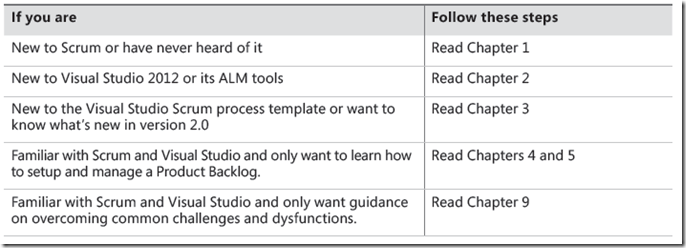RTM’d today: Professional Scrum Development with Microsoft Visual Studio 2012
We are pleased to announce that Professional Scrum Development with Microsoft Visual Studio 2012 (ISBN 9780735657984) has been sent to the printer! This book will be shipped to retailers in just a few weeks.
Here is a quick look at the contents:
Contents at a Glance
Foreword
Introduction
PART I FUNDAMENTALS
CHAPTER 1 Scrumdamentals
CHAPTER 2 Microsoft Visual Studio 2012 ALM
CHAPTER 3 Microsoft Visual Studio Scrum 2.0
PART II USING SCRUM
CHAPTER 4 The pre-game
CHAPTER 5 The Product Backlog
CHAPTER 6 The Sprint
CHAPTER 7 Acceptance test-driven development
CHAPTER 8 Effective collaboration
PART III IMPROVING
CHAPTER 9 Continuous improvement
Appendix: The Scrum Guide
Index
Here is an excerpt from the Introduction:
Introduction
Scrum is a framework for developing and sustaining complex products, such
as software. Scrum is just a set of rules, as defined in the Scrum Guide (www.scrum.org/Scrum-Guides),
and it describes the roles, events, and artifacts, as well as the
rules that bind them together. When used correctly, this framework enables a team to
address complex problems while productively and creatively delivering products of the
highest possible value. Scrum is an Agile method. In fact, it is the most popular Agile
method in use today.
Scrum employs an iterative and incremental approach to optimizing predictability
and controlling risk. This is due to the empirical process control nature of Scrum.
Through proper use of inspection, adaptation, and transparency, a Scrum Team can try
a new way of doing something (an experiment) and gauge its usefulness after a short
iteration. They can then collectively decide to embrace, extend, or drop the practice.
This includes the tools a team uses and how they use them.
Combining Scrum with the application lifecycle management (ALM) tools found in
Microsoft Visual Studio 2012 is a powerful combination. It is the purpose of this book
to establish a baseline understanding of Scrum, as well as how Scrum is supported
in Visual Studio 2012. I will also illustrate which practices provide more value when
executed without the use of tools. In addition, I will point out those tools which have been
erroneously marketed as healthy when used by a collocated, collaborative Scrum Team.
In software development, anything and everything can change in a moment’s notice.
Healthy teams know this. They also know that continuously inspecting and adapting the
way things are done is a way of life. High-performance Scrum Development Teams take
it a step further. They know that within every dysfunction or impediment identifi ed is an
opportunity to learn and improve. Reading this book is a great fi rst step.
Who should read this book
This book will be of value to any members of a software development team using
Scrum. I primarily focus on the responsibilities and tasks of the developer (which in
Scrum includes designers, architects, coders, testers, technical writers, etc.). Product
Owners and Scrum Masters will also derive value from this book, as they will be using
many of the same Visual Studio tools to plan and manage their work and assess
progress. Stakeholders, including customers, users, and managers, will also gain value
from this book, especially when they learn what they can and cannot do according to
the rules of Scrum and which tools in Visual Studio support this.
Who should not read this book
This book is intended for teams using Scrum and Visual Studio 2012 together. It won’t
provide as much value for teams executing Agile (non-Scrum) software development
and won’t provide any value for teams running more formal “waterfall” software
development projects, although Chapter 1 may hopefully change the minds of such
proponents. Likewise, if a team is using Scrum, but not yet using Visual Studio 2012,
the bulk of the book won’t be very interesting. This is also the case for teams using
Visual Studio 2012 Express or Professional editions, which don’t contain the high-value,
team -based tools for planning and managing the backlogs and team collaboration.
Organization of this book
This book is divided into three sections, each of which focuses on a different aspect
of the marriage of Scrum and Visual Studio. Part I, “Fundamentals,” sets a baseline
understanding of the Scrum framework, Visual Studio 2012 editions and their
interesting ALM features, as well as the Visual Studio Scrum 2.0 process template.
Part II, “Using Scrum,” provides several chapters detailing the practical application
of how a Scrum Team would use the relevant features of Visual Studio 2012. Part III,
“ Improving,” includes a chapter on identifying common challenges and dysfunctions
in order to remove them, as well as techniques to continually improve your game of
Scrum. By reading all sections sequentially, you will see how Visual Studio and
Scrum can be used together in an effective way and how a team can become
high - performance in the way it develops software.
Finding your best starting point in this book
The different sections of Professional Scrum Development with Microsoft Visual
Studio 2012 cover a range of topics. Depending on your needs and your existing
understanding of Scrum, Visual Studio, and the related development practices, you may
wish to focus on specific areas of the book. Use the following table to determine how
best to proceed through the book.
